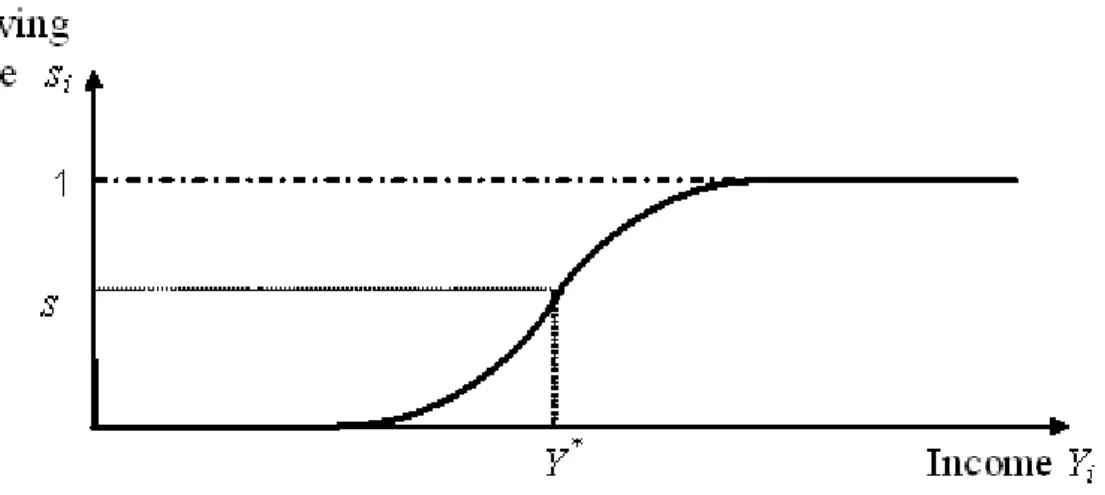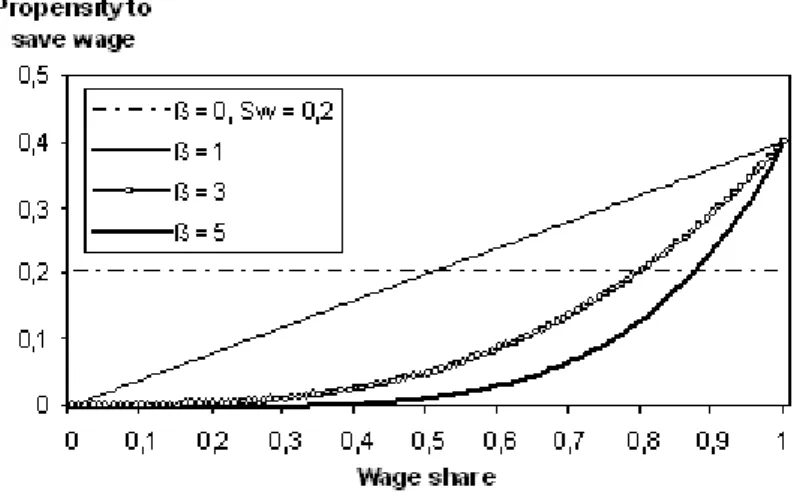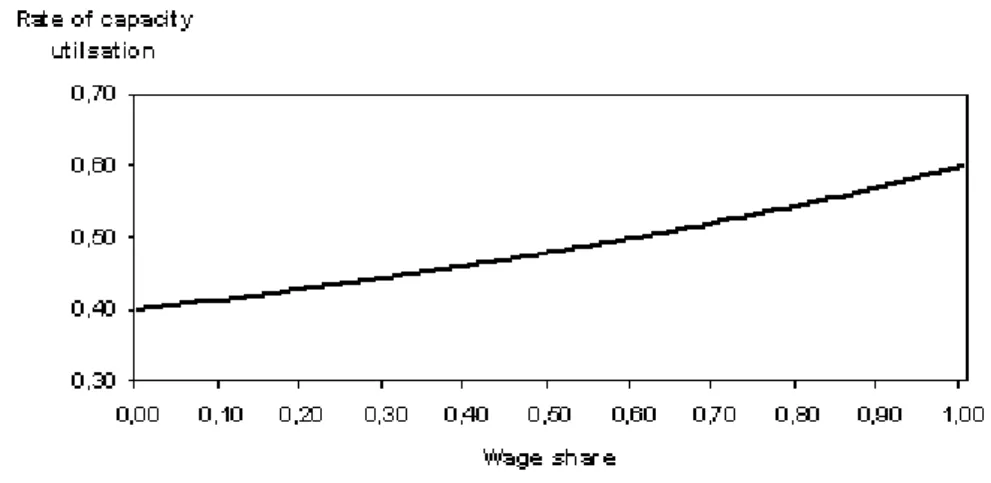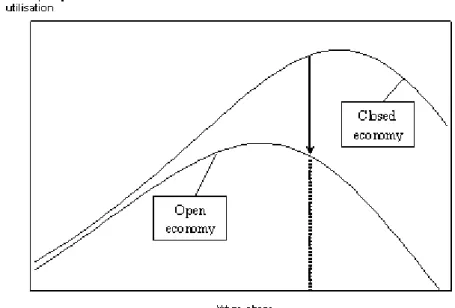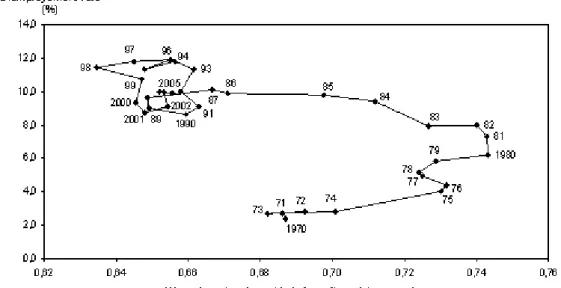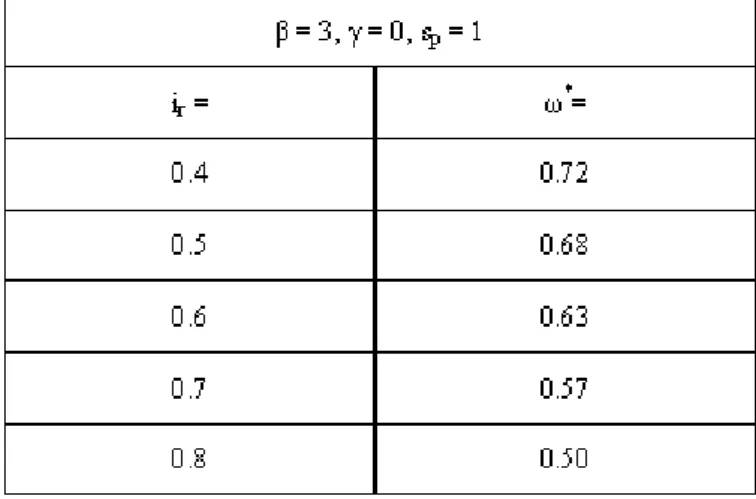HAL Id: halshs-00149388
https://halshs.archives-ouvertes.fr/halshs-00149388
Submitted on 9 Jun 2007HAL is a multi-disciplinary open access
archive for the deposit and dissemination of sci-entific research documents, whether they are pub-lished or not. The documents may come from teaching and research institutions in France or
L’archive ouverte pluridisciplinaire HAL, est destinée au dépôt et à la diffusion de documents scientifiques de niveau recherche, publiés ou non, émanant des établissements d’enseignement et de recherche français ou étrangers, des laboratoires
Profit-led or Wage-led Regimes: the Effect ofSaving
Behaviours
Nicolas Canry
To cite this version:
Nicolas Canry. Profit-led or Wage-led Regimes: the Effect ofSaving Behaviours. Colloque CES-MATISSE “ Etat et régulation sociale. Comment penser la cohérence de l’intervention publique ? ”, Sep 2006, Paris, France. �halshs-00149388�
Pro…t-led or Wage-led Regimes: the E¤ect of
Saving Behaviours
Nicolas CANRY
CES Matisse, Université Paris 1
MSE - Bureau 216 - 106-112, boulevard de l’hôpital
75013 Paris. France
nicolas.canry@univ-paris1.fr
Abstract
In this article, we modify the saving function of the Bhaduri-Marglin model and obtain a hump-shaped curve of output in function of wage-share: the nature -exhilarationist or stagnationist- of the economic regime depends on the level of income distribution. Economic policy can thus consist of shift-ing income distribution by redistributive policy in order to stimulate output. These conclusions remain valid in open economy, even if the exhilarationist regime is then more likely to arise. At last, we adopt a dynamic perspective by adding a wage equation to the model, which is thus characterised either by cycles or an underemployment equilibrium.
Key words: Cycles, Income share, Post-Keynesian theory, Saving, Un-employment.
JEL Classi…cation: E12, E21, E24, E25.
1. Introduction
Many Post-Keynesian authors (Rowthorn, 1981; Dutt, 1984; Bhaduri and Marg-lin, 1990; Lavoie, 1995) have tried to show that the relation between growth and income distribution (between wages and pro…ts) was not clear cut. Income distri-bution determines growth through its e¤ects on both investment and consumption behaviours. Let us suppose an increase of pro…t share in total value added: this is likely to increase investment by …rms but, in the same time, it will have a negative impact on consumption by households. If the …rst e¤ect is more important than the second one, the regime is exhilarationist. On the contrary, if the negative e¤ect on
consumption (we could also say: the positive e¤ect on saving) outweighs the pos-itive e¤ect on investment, the regime is stagnationist. The main conclusion is that the nature of the regime crucially depends on the respective sensitivity of both investment and saving to income distribution evolutions. Unfortunately, these sensitivities (which are re‡ected by constant parameters in this kind of model) are supposed exogenous in the comparative static frame that these authors have adopted. These models thus study the conditions that an economy must ful…l to be either exhilarationist or stagnationist but dynamic issues explaining how an economy switch from one regime to another are rarely tackled.
One way to introduce such dynamic issues consists of introducing non linearity in investment behaviour by …rms. Many contributions which adopted the frame-work of disequilibrium theory focused on this way in the early 1980s (Artus and Muet, 1986; Muet and Sterdyniak, 1987). These models generally assume that investment equation depends on two components: one for demand e¤ect, one for pro…tability e¤ect. Actual investment is determined by the “binding” component (i.e. the weakest component). Accordingly, an economy can switch from one re-gime to another because of a change in the component which restricts investment. However, this framework remains static and the links relating income distribution to economic growth are not the core of the issue anymore.
In this article, we adopt a di¤erent perspective: instead of modifying investment function, we focus on saving function. In that perspective, we refer to the Bhaduri-Marglin model that we very slightly modify by changing its saving function. The pretty intuitive hypothesis that we then introduce is that propensity to save by agents increases with their income. Thanks to this new simple hypothesis, we show that the nature of the regime does not depend only on exogenous parameters anymore ; it also depends on the level of income distribution. Our main conclusion is thus that the e¤ect of wage-share variations (or, symmetrically, of pro…t share variations) depends on the initial level of wage share. Note that the hump-shaped curve we …nally get had already been suggested by Taylor (1991)1.
The …rst section of this article is devoted to a brief presentation of the Marglin model (1990). In section 2, we modify the saving function of the Bhaduri-Marglin model and show how it allows to generate an inverted U-shaped curve between wage-share and output. In the third section, we brie‡y analyse the im-plications of the model for economic policy. In the fourth section, we enrich our model by opening the economy. In the …fth section, we adopt a dynamic per-spective by introducing a wage equation in the model: we then show that the dynamic can either be characterised by cycles (the economy switching periodically from wage to pro…t-led regime and vice versa) or converge toward a Keynesian equilibrium (characterised by both low wage share and high unemployment rate). At last, we conclude.
2. The Bhaduri and Marglin model (1990)
The Bhaduri-Marglin model analyses the e¤ects of income distribution on growth through the impact of pro…t-share evolutions upon investment and savings. The authors show that the level of activity can be supported either by wages increase (wage-led regime) or pro…ts increase (pro…t-led regime).
In their model, consumption is given by:
C = (1 sw)W + (1 sp)P (1)
where W is the payroll, P are the total pro…ts (Y = P + W ), sw and sp are saving
propensities of workers and capitalists respectively, with sp > sw. It follows that:
S
K = z [(sw sp)! + sp] (2) with K, the level of physical capital in the economy, S the saving, ! = WY (wage share), z = YY (where Y is the output level when the capital stock is fully used; z is the rate of capacity utilisation), and = KY (constant).
The investment function has two explicative variables: the pro…t rate r =
P
K and the rate of capacity utilisation z, which captures a demand e¤ect:
I K = i0+ ir P K + iz Y Y = i0+ z(ir (1 !) + iz) ir; iz > 0 (3) where ! = WY . As KI = KS, we get a relation between z and !:
z = i0
(ir (sp sw)) ! + ((sp ir) iz)
(4)
The "Keynesian stability" condition, according to which saving must be more sensitive to variations of z than investment, implies that the denominator of equa-tion (4) must be positive. The equilibrium of the model z is thus positive if i0 is
positive, which is assumed afterwards.
An economy is wage-led if @!@z > 0 and pro…t-led otherwise. The nature of the economic regime rests only on the sensitivity of both saving and investment to variations of the wage-share !, i.e. the economy is wage-led if:
ir < sp sw (5)
From a graphical standpoint, the nature of the regime depends on the sensitivity of the slope of both saving and investment curves to variations of wage-share.
Therefore the market equilibrium condition implies either an increasing or a decreasing relation between wage share and output. The e¤ect of pro…t on output is then unclear.
Nevertheless, two important limits of the Bhaduri-Marglin model must be un-derlined:
- It seems that the pro…t-led regime is unlikely to occur for realistic values of parameters of this model (Blecker, 2002). In the extreme (but usually assumed by many Post-Keynesian authors) case where sw = 0 and sp = 1, the condition
for which the economy is pro…t-led becomes (from equation (5)) ir > 1, which is
incompatible with the condition of Keynesian stability. Thus, with this extreme but very usual hypothesis on saving behaviours, the regime is necessarily wage-led. To get a pro…t-led regime in the Bhaduri-Marglin model, both strong sensitivity of capital accumulation to pro…t rate and weak propensity to save pro…ts (rather counterintuitive hypothesis) must be assumed.
- In his review of the Bhaduri-Marglin model, Taylor (1991) suggests that the nature of the economic regime can directly depend on the “initial” level of wage-share: the greater it is, the more likely is the economy to be pro…t-led (in other words, when wage-share is high, its decrease should boost the level of activity). This rather intuitive interpretation can be illustrated by an inverted U-shaped curve. However, this representation does not correspond at all to the analytical model of Bhaduri-Marglin, since the sign of !z from (4) does not depend on !. In the Bhaduri-Marglin model, only an "exogenous" shift of parameters in saving (sp
or sw) or investment (ir) functions will allow to switch from one regime to another.
Evolutions in income distribution a¤ect the level of activity in the economy but not the nature of the regime (wage or pro…t-led ).
3. Formalising the "Taylor curve"
In this section, we enrich the Bhaduri-Marglin model in order to give a math-ematical formalisation of this "Taylor curve", which has, to our knowledge, never been carried out. Indeed, formalising the "Taylor curve" implies to introduce nonlinearities, either in the investment function or in the saving function of the model.
In this article, it is the saving function which is modi…ed. In most of Post-Keynesian models indeed, it is assumed that agents (workers or capitalists) save a constant part of their income; this (constant) saving rate depends only on the kind of the income, wage or pro…t. This means that, for each kind of income, the marginal propensity to save is constant. On the contrary, we suppose here that:
- on the one hand, the propensity to save income is not related anymore to the nature of income: for every agent, it depends only (and more generally) on level of income of each agent (whatever this income, wage or pro…t).
- on the other hand, the marginal propensity to save income is positive. If we note si the average propensity of agent i to save its income Yi, we then have:
si =
Si
Yi
= f (Yi) (6)
Moreover, we suppose that f has the shape of a logistic function, i.e. we suppose that : i) f (0) = 0 ii) f0 = dsi dYi 0 8Yi 0 iii) 9Y > 0 f00(Y ) = 0 iv) 8Yi < Y f00(Yi) > 0 and 8Yi > Y f00(Yi) < 0
v) limYi!Y f (Yi) = s and limYi!1f (Yi) = 1.
The saving rate of agent i is thus depicted in …gure 2.
Fig. 2. The average propensity to save income by agent i in the model. In this frame, we distinguish workers from capitalists only by assuming that the pro…t of each capitalist exceeds Y , whereas the wage of each worker does not2.
This hypothesis suggests that capital incomes are more concentrated than labours incomes.
3.1. Saving behaviour by workers
We assume that each (employed) worker j supplies one (indivisible) unity of labour, which allows to produce a unities of …nal good (once capital is installed). The average labour productivity a is supposed constant and identical for all workers. If employed, this worker earns a wage w (identical for any employed worker). If unemployed, the worker earns no income (for simplicity, we suppose that, in that case, w = 0). Propensity to save wage by worker i is given by :
Sw;j
w = sw;j(w) (7) As workers cannot increase their labour supply, every increase of output volves hiring of new workers by …rms, so that only wage variations allow to in-crease the income of employed workers. Moreover, if wage w exceeds the labour productivity a, …rms will have no interest to produce: this is the reason why w can vary from 0 to a 3. At last, to ful…ll conditions i) to v) presented above, we
suppose that:
sw;j = s
w
a = s! = sw (8)
with > 1 and 1. Without loss of generality, we suppose afterwards that = 1.
Figure 3 displays average propensity to save wage by workers depending on wage share level !, for di¤erent values of . In these simulations, we suppose that s = 0:4 (note that in the Bhaduri-Marglin model, propensity to save wage is constant and does not therefore depend on wage share at all: this case is presented on the …gure for sw = 0:2). Note that the more important is , the weaker is the
propensity to save wage, whatever the wage share level !.
Fig. 3. The propensity to save wage for di¤erent values of . 3.2. Saving behaviour by capitalists
We assume that each "capitalist" k supplies a …xed quantity m of capital, each unity of capital allowing to produce unities of output (in the case of full utilisation of capital, which is not necessarily the case in our model). As all capitalists are identical, they earn the same pro…t rm, where r = KP is the pro…t rate at macroeconomic level. Average propensity to save pro…t by capitalist k is given by:
Sp;k
rm = sp;k(rm) (9) On the one hand, as we assume that each capitalist earn an income superior to Y (see …gure 2), we must suppose that:
r Y
m (10)
On the other hand, we suppose that propensity to save pro…t sp;k is an
increas-ing function of pro…t rm. In this section, we suppose that m is constant, so that the evolution of capitalists’income depends only on r, which can be written:
r = P Y Y Y Y K = z (11)
The return on capital is then bounded by the productivity of capital , so that we can suppose that:
sp;k =es
r
; 0 1 (12)
From (11) and (12), we thus get:
sp;k =es( z) = sp (13)
To be in accordance with …gure 2, it is necessary to suppose es = 1. The main di¤erence with the saving rate by workers is that capitalists’income increases with the rate of capacity utilisation z: as capital can be underemployed in our model, an increase of output will increase both rate of capacity utilisation and individual
income of capitalists. Nevertheless, this result makes our model more complicated to solve.
3.3. Equilibrium
With our new hypotheses on saving behaviours by agents, equilibrium condition of the model (equation (4) of the Bhaduri-Marglin model) is given by:
z(ir es(1 !) z s! ) ! + ((es(1 !) z ir) iz) i0 = 0 (14)
In a …rst step, we will suppose that = 0, which means that saving rate by capitalists is constant (and equal to 1), as in Bhaduri-Marglin model, so that only saving behaviour by workers is modi…ed (by comparison to the Bhaduri-Marglin model): this …rst step allows to get a model which is very easy to solve. In a second step, we will suppose that > 0: with such a condition, the model becomes much more complicated to solve, which compels us to use simulations to present results of the model in that case. At last, as iz has a quite weak impact on our main
conclusion, we will suppose that this parameter is equal to 0.
3.4. First case: endogenous propensity to save wage ( > 1), constant propensity to save pro…t ( = 0, sp =es)
From equation (14), it results that economy is wage-led if:
! < sp ir s(1 + )
1=
(15) Figure 4 displays the level of activity (captured by the rate of capacity utilisa-tion z) according to wage share level ! for di¤erent values of . For the simulautilisa-tions, values of parameters are: s = 0:4, es = 1, ir= 0:7 and i0 = 0:12.
Fig. 4. The relation between wage share and rate of capacity utilisation for di¤erent values of .
From …gure 4, we notice that the greater is , the greater is the rate of capa-city utilisation z, whatever !: this can be easily explained by remembering that propensity to save wages decreases with (for any !). Moreover, the greater is ;the more sensitive is z to wage share evolutions. But the main conclusion from …gure 4 is that whatever , there is a threshold value ! of wage share, separating a wage-led from a pro…t-led area. In the Bhaduri-Marglin model, this threshold value does not exist, whatever the values of the parameters in the model. On …gure 5, we present the result of the simulation when = 0 (other parameters remaining unchanged, by comparison with …gure 4), which corresponds to the
Bhaduri-Marglin model when sp = 1, sw = 0:2, ir= 0:7 and i0 = 0:12(in this case
the regime is wage-led whatever the level of the wage share).
Fig. 5. The relation between wage share and rate of capacity utilisation in the Bhaduri-Marglin model (case of a wage-led regime).
Thus a very simple change on saving behaviours by households is su¢ cient to generate a frame in which the nature of the regime depends on wage share variable. To the left of ! (see equation (15)), every rise of wage share increases output since positive e¤ect on consumption outweighs the (possible) negative e¤ect on investment (note that investment itself may even be supported by an accelerator e¤ect in this case). On the contrary, to the right of ! , output level is restricted by insu¢ cient investment and pro…t-squeeze (every wage share decrease will support investment more than it depresses consumption in this area).
At last, note that:
- on the one hand, the greater , the greater ! , the threshold value of wage share separating the two regimes.
- on the other hand, the greater , the greater the sensitiveness of z (the rate of capacity utilisation) to variations of income distribution.
Table 1 sums up the main conclusions of these simulations: Table 1. Value of the threshold ! for di¤erent values of .
3.5. Second case: endogenous propensity to save wages ( > 1) and pro…ts ( > 0) We now assume that propensity to save pro…t is also endogenous. The purpose of this section is only to show that the main conclusion of the previous section is not a¤ected by this additional hypothesis. Thus we take the same values for parameter as previously. We take = 3 and make simulations for three di¤erent values of : = 0 (as in the previous section), = 0:2 and = 0:4. Figure 6 displays the results.
Fig. 6. The relation between wage share and rate of capacity utilisation for di¤erent values of .
From …gure 6, we notice that the greater is , the greater is the rate of capacity utilisation z whatever !, because the propensity to save pro…t decreases with (for any !). Moreover, the greater is , the more sensitive is z to wage share evolutions, especially in the pro…t-led regime. Thus the introduction of endogenous propensity to save pro…ts makes the model much more complicated but it does not a¤ect its main conclusions at all, namely the nature of the regime -wage or pro…t-led - directly depends on the level of income distribution. This is why, it will be assumed, in next sections and for more simplicity, that = 0.
4. Implications for economic policy
One central conclusion of the model presented in previous section is that there is (at least from a theoretical standpoint) a value of wage-share ! for which output is at its optimal level. In this frame, economic policy can consist of leading a redistributive policy which moves the wage-share closer to ! . This could be carried out through a …scal policy, which would transfer income from one kind of agent (worker or capitalist) to another (note however that the purpose of this policy is not equity but e¢ ciency). Such a policy requires a good diagnosis of the economic situation, since a given level of output can result from two di¤erent values of wage-share (one in the wage-led area and one in the pro…t-led area). Indeed, the …scal transfer directly depends on the economic regime in which the economy actually is. Fiscal policy consists of boosting demand through the support of either consumption by households or investment by …rms. For example, if the economy is in the wage-led regime, economic policy will transfer capital incomes toward "labour incomes" (or households)4.
5. Opening of the economy 5.1. Net exports
Our model can be enriched by opening the economy. The equilibrium on goods markets is thus given by:
S K = I K + X M K (16)
and the equation of net exports formation must be formulated. Bowles and Boyer (1995) assume that net exports are positively related to the national pro…t rate r:
X M
K = x0 + xrr xr 0 (17) Many explanations can support this hypothesis: a wage share increase may bring about in‡ation and a loss of competitiveness; higher pro…t rate will increase investment and R&D expenditure, which will improve technical progress and even-tually competitiveness; higher pro…tability makes easier for …rms to reduce their markup on foreign markets, etc.
In the Bhaduri-Marglin model, the new condition for the economy to be wage-led is then:
So Bowles and Boyer conclude that the economy is more likely to be pro…t-led in the frame of an open economy. In our model, the economy is wage-led if:
! < sp ir xr s(1 + )
1=
(19) So, the value of the threshold ! separating wage and pro…t-led regimes is now weaker (than in the case of a closed economy).
5.2. Foreign direct investments
Another way to open the economy is to suppose that investment may be carried out either within the country or overseas, according to the gap between national and worldwide pro…t rates. In this perspective, investment function is given by:
I
K = i0+ ir(r r) (20) where r is the worldwide pro…t rate5. Equation (20) can be rewritten as follows:
I
K = (i0 irr) + irr (21) Actually, only the constant term of investment function is negatively a¤ected by the introduction of foreign investments. As the threshold ! does not depend on this constant term, the main conclusions of our model remain unchanged, which is of course not satisfying. As suggested by Blecker (2002), the way through which globalisation is more likely to a¤ect national investment is a change in the sensitivity of investment to pro…t rate, i.e. an increase of irin equation (20). Table
2 gives the evolutions of the threshold ! (separating wage and pro…t-led regimes) as ir increases.
Table 2. Value of the threshold ! for di¤erent values of ir.
Eventually, the impact of globalisation can be simulated as a shock to the economy which modi…es both the constant term (which decreases) and parameter ir (which increases) in investment function. This shock thus brings about both
a decline in output and a shifting of ! to the left, which means that "after" openness, the economy is pro…t-led for weaker values of the wage-share (this result is in accordance with Bowles and Boyer conclusion). This shifting might also make the economy switch from one regime (wage-led regime) to another (pro…t-led regime) as it is depicted in …gure 7. Indeed, a drop of wage share may now boost national investment (by improving national pro…tability relatively to worldwide pro…tability) and increase output (in spite of consumption reduction). At last, redistributive policy is likely to be more di¢ cult in such a context, especially because of capital incomes ‡ight.
Fig. 7. The relation between wage share and rate of capacity utilisation before and after international openness.
6. A dynamic model
We now introduce dynamic aspects in our model. For that, we propose a very simple wage equation that we combine with our inverted U-shaped curve (corresponding to equilibrium on the goods market). So, the dynamic dimension of the model comes from the endogeneity of the wage share. In our model, we suppose that labour productivity a remains constant over time, so that wage share remains constant if real wage remains itself constant6. We simply suppose that
when employment level (captured in our model by the rate of capacity utilisation) is high, workers manage to get higher (real) wages w, because their bargaining power is stronger when the economy is closer to full-employment. Thus, we suppose that, beyond a certain value z of the rate of capacity utilisation z, real wage is positively related to z:
w = w for any z < z
w = w + z otherwise (22) Note immediately that these equations can be rewritten as:
! = ! for any z < z
! = ! + z otherwise (23) with ! = w
a and = a.
On Figure 8, we accordingly combine our inverted U-shaped curve with our wage-setting curve. On the one hand, output is set on the goods market by ag-gregate demand, which itself depends on the wage share (through its impact on both investment and consumption). As long as wage share is below ! (but bey-ond A), there is a virtuous dynamics: wage increases support consumption (and maybe also investment) and eventually output, which in turn brings about wage increases. On the contrary, beyond ! , pro…ts are squeezed so that every wage increase depresses investment more than it boosts consumption. Only a decrease of the wage share could recover investment and output in this area. This wage drop is actually allowed by the recession consecutive to investment decline. So, this dynamics generates cycles (pretty similar to those depicted by the model of Goodwin, 1967) around one …rst equilibrium. Nevertheless, we see on …gure 8 that this dynamics may also bifurcate to another equilibrium, where wage share and output are both very low. This is the case if the wage share reduction is too important during the recession period (of the cycle). As soon as investment is restored when consumptions drops, cycles are maintained although the model
is demand constrained. However, a strong wage austerity may also depress con-sumption so much that it prevents investment to recover in spite of the increase of pro…t share. Consumption and investment thus fall together. Cycles disappear be-cause neither consumption nor investment can sustain demand and output, which induces a cumulative slump: slowdown exacerbates wage-share fall, whereas the economy is in the wage-led area. Finally, this "cumulative recession" stabilises to a new equilibrium, characterised by high unemployment and weakness of global demand. This is the reason why we call it a "Keynesian equilibrium".
Fig.8. Combining the inverted U-shaped curve with a wage-setting curve.
7. An interpretation of the French economic dynamic since 1970 Thanks to this model, we propose an interpretation of growing unemployment which characterised the French economy in the 1980s and 1990s. In the 1960s, unemployment remained below 3 %. This situation strengthened the bargaining power of trade unions in a context of labour productivity growth slowdown. This partly explained the takeo¤ of wage-share in the 1970s which squeezed pro…ts and reduced investment (Bruno and Sachs, 1985). At the beginning of the 1980s, the competitive disin‡ation was run with the purpose to decrease unemployment by promoting exportations through in‡ation …ght (Blanchard and Muet, 1993) and investment through pro…t recovery (and wage austerity). Unfortunately, the rise of pro…t-share in the 1980s came along with a very short decrease of unemployment. Our model proposes an explanation of the lasting and joint increase of unemploy-ment and pro…t-share (which reached historical high levels in the 1990s without sensitive e¤ect on investment) from 1982 to nowadays: the French economy might well be stuck for …fteen year in a "Keynesian equilibrium" because wage-share dropped too much, which has a strong negative e¤ect of demand.
Fig. 9. The relation between wage share and unemployment rate in France from 1970 to 2005.
8. Conclusion
In this article, we enrich the Bhaduri-Marglin model (1990) by supposing that saving behaviours (more precisely, average propensity to save income) by agents vary as their income changes. Such a pretty simple hypothesis allows to generate a analytical framework where the nature of the economic regime –wage or pro…t-led, as underlined by Bhaduri and Marglin– depends directly on income distribution, i.e. the level of the wage share (or pro…t share symmetrically): this means that
there exists a threshold value of wage (or pro…t) share ! which separates the two distinct regimes. To the left of ! , economy is wage-led, to its right, economy is pro…t-led. Such a result is obtained by just assuming that, for "extreme" income distributions, national saving rate increases a lot. This result has also important implications for economic policy. First, to a same level of unemployment can cor-respond very contrasted economic policies, depending on whether the economy is wage or pro…t-led. Secondly, economic policy must try to move income distribution closer to ! . We then show that the pro…t-share area is likely to be larger as inter-national openness arises. In the same time, economic policy will be more di¢ cult to lead (greater capital mobility, increasing …scal competition, etc.). At last, we introduce in such a framework a wage formation equation to make this model dy-namic. We then show that the model can generate economic cycles, the economy oscillating between wage and pro…t-led regimes: if economy is in its wage-led area, a virtuous cycle can happen: wage increases support consumption and eventually output which in turn brings about wage increase. Unfortunately, wage share will …nally go beyond ! , which will depress investment and cause a recession. This recession dampens wages, which in turn restores output, and so on. However we show that a too large wage decrease can reduce consumption so much that in-vestment will not take o¤ despite pro…t restoration. In that case, inin-vestment and consumption decline together as in a typical Keynesian unemployment case. This theoretical result allows to understand the trajectory of the French economy from 1970 to nowadays.
Bibliography
Artus, P. and Muet, P.-A. 1986. Investissement, contraintes de débouchés d’emploi et contraintes …nancières : estimation d’un modèle à plusieurs régimes, pp. 211-244 in Artus P. and Muet P.-A.(eds), Investissement et emploi, Paris, Economica Bhaduri, A. and Marglin, S. 1990. Unemployment and the Real Wage: the Eco-nomic Bases for Contesting Political Ideologies, Cambridge Journal of EcoEco-nomics, vol. 14, no. 4, 375-393
Blanchard, O-J. and Muet, P-A. 1993. Competitiveness through Disin‡ation: an Assessment of the French Macroeconomic Strategy, Economic Policy, vol. 8, no. 1, 12-56
Blecker, R. A. 2002. Distribution, Demand and Growth in Neo-Kaleckian Macro-models, pp. 129-152 in Setter…eld M. (eds), The Economics of Demand-led Growth, Cheltenham, Edward Elgar
Bruno, M. and Sachs, J. 1985. The Economics of Worldwide Stag‡ation, Oxford, Basil Blackwell
Bowles, S. and Boyer, R. 1995. Wages, Aggregate Demand and Employment in an Open Economy: an Empirical Investigation, pp. 143-171 in Epstein G. A.and
Gintis H. M (eds), Macroeconomic Policy after the Conservative Era, Cambridge, Cambridge University Press
Canry, N. 2005. Régime wage-led, régime pro…t-led et cycles : un modèle, Eco-nomie Appliquée. vol. 58, no. 1, 143-163
Dutt, A. K.1984. Stagnation, Income Distribution and Monopoly Power, Cam-bridge Journal of Economics, vol. 8, no. 1, 25-40
Goodwin, R.M. 1967. A Growth Cycle, pp. 54-58 in Feinstein, C. H. (eds), Capitalism and Economic Growth, Cambridge, Cambridge University Press Lavoie, M. 1995. The Kaleckian Model of Growth and Distribution and its Neo-Ricardian and Marxian Critics, Cambridge Journal of Economics, vol. 19, no. 6, 789-818
Muet, P.-A. and Sterdyniak, H. 1987. Investment, Pro…tability and Classical Un-employment, pp. 319-356 in Champsaur P. and alii (eds), Essays in Honor of Edmond Malinvaud, Cambridge, Mass. and London, MIT Press
Rowthorn, R. 1981. Demand, Real Wages and Economic Growth, Thames Papers in Political Economy, Autumn, 1-39
Taylor, L. 1991. Income Distribution, In‡ation and Growth. Lectures on Struc-turalist Macroeconomic Theory, Cambridge, Mass. and London, MIT Press Taylor, L. 2004. Reconstrcuting Macroeconomics: Structuralist Proposals and Cri-tiques of the Mainstream, Harvard, Harvard University Press
Footnotes
1 Note also that, for simplicity and following Taylor (1991, 2004), we use
indif-ferently the terms "exhilarationist regime" and "pro…t-led regime" in this article i.e. an economic regime in which a rise of pro…t-share increases output (precisely the rate of capacity utilisation), even though these terms correspond to di¤erent concepts in Post-Keynesian literature. Likewise, we use indi¤erently the terms "stagnationist regime" and "wage-led regime" i.e. an economic regime in which a rise of wage-share increases output.
2We also suppose, which is a strong hypothesis, that capitalists are not workers,
and vice versa.
3 This result implies that, in our model, a < Y .
4 It will be quite the contrary (for example, economic policy could thus boost
investment either through subsidies or through tax incentive measures) if the eco-nomy is pro…t-led. Moreover, note that redistributive …scal policy allows to increase households (workers) incomes without increasing labour costs.
5 Remember that we suppose, for simplicity, that i z = 0.
6 If labour productivity grows at a constant pace, wage share is constant as
Figures
Fig. 1. Graphical characterisation of wage and pro…t-led regimes.
Fig. 3. The propensity to save wage for di¤erent values of .
Fig. 4. The relation between wage share and rate of capacity utilisation for di¤erent values of .
Fig. 5. The relation between wage share and rate of capacity utilisation in the Bhaduri-Marglin model (case of a wage-led regime).
Fig. 6. The relation between wage share and rate of capacity utilisation for di¤erent values of .
Fig. 7. The relation between wage share and rate of capacity utilisation before and after international openness.
Fig. 9. The relation between wage share and unemployment rate in France from 1970 to 2005 (sources: INSEE, National Accounts).
Tables
Table 1. Value of the threshold ! for di¤erent values of .
